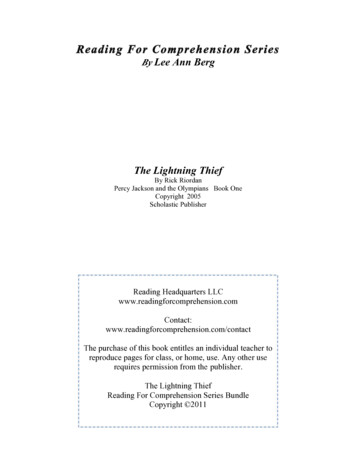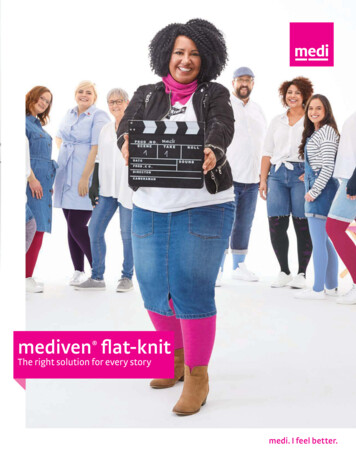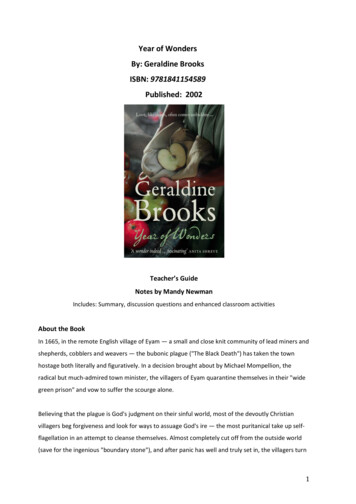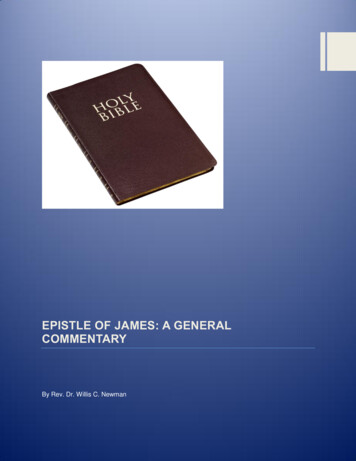
Transcription
Knit Together: A Study of Late Nineteenth-Century Knitting Patterns Through ContemporaryEyes and Handsby Courtney ModdleA thesis submitted to theSchool of Graduate Studiesin partial fulfillment of the requirements for the degree ofMaster of Gender StudiesMemorial University of NewfoundlandDecember 2017St. John’s, Newfoundland and Labrador
AbstractDespite, or perhaps because of its familiar role in society, knitting has often beenconsidered as little more than a craft or hobby and too mundane to study in an academic sense.Yet, everyday activities, like knitting, can often offer significant information about society,culture, and individuals’ lives. Focusing on the connections between past and present, betweencurrent knitters and their predecessors, my project examines historic knitting practices through acontemporary feminist lens. My research argues that a study of knitting books published in thelate 1800s can provide new perspectives on women’s lives and the knitting culture that theyparticipated in. Furthermore, a thorough analysis of these texts may change the way modernknitting culture is perceived. To deepen my understanding of the historic knitting patterns, Iengaged in an autoethnographic knitting project as I knit through historic patterns.Keywords: autoethnography, knitting, stitch ‘n bitch, 19th century, leisure, craftivismii
AcknowledgementsThere are many people who contributed to this thesis in a variety of different ways. Iwould first of all like to thank my co-supervisors Dr. Diane Tye and Dr. Sonja Boon. Thank youfor your patience, and enthusiasm and for sharing your wisdom and knowledge with me.I would also like to acknowledge the department of Gender Studies, and all of mysupervisors and classmates, for all of the support and knowledge shared over the past two years. Ioffer a special thank you to my thesis writing buddy Lesley Derraugh, I hope we were able tooffer more encouragement than distraction to each other. Also to Jillian Ashick-Stinson, fortelling me that I should just write a thesis about knitting already.I am thankful for the support of all of my friends and family, especially my partnerChristopher. Thank you for all of your support and encouragement, and for believing in me whenI don’t. Thank you for listening to my endless complaints that writing is hard, for reading drafts,and always letting me talk through my ideas with you. To my cats, Rupert, Janice and Bunsen.Thank you for not forgetting about me when I went to live in a different province, and for alwaysbeing the first to appreciate my knitting. Thank you to my Gramma, for being so cool that “notyour grandmother’s knitting” never seemed like a compliment.iii
Table of ContentsAbstractiiAcknowledgementsiiiTable of FiguresviChapter One: Introduction71.1 Why Knitting?71.2 My Story101.3 My Project121.4 The Pattern Books181.5 Chapter Outline24Chapter Two: Literature Review25Chapter Three: Theory and Methodology373.1 Theory373.2 Methodology443.3 Feminist Research Methodologies453.4 Ethnographic Content Analysis493.5 Material Culture Studies503.6 Autoethnography as Method523.7 Writing as Inquiry54Chapter Four: Knitting as Inquiry: My Autoethnographic Journey through Late NineteenthCentury Knitting Patterns4.1 Knitting as Inquiry5859iv
4.2 Autoenthographic Project624.3 Getting Started624.4 Beginning to Knit684.5 Choosing Materials704.6 Historic Patterns vs. Contemporary Patterns76Chapter Five: In Women’s Words: Understanding Knitting History Through Women’s Writing825.1 Knitting for Pleasure825.2 Process-Oriented Knitting835.3 Anne Langton855.4 L. M Montgomery865.5 The Rural Diary Archive895.6 A Look at the History975.7 Women’s Roles, Knitting and Feminism1005.8 Conclusion105Chapter Six: Conclusion107Works Cited111v
Table of FiguresFigure 1.1: A pair of mittens I recently knit, and matching sweater and mittens knit by mypartner’s grandmother.12Figure 1.2: Knit section of “No. 116 –Lace Collar No. 5” from Home Work.16Figure 4.1: Pattern for “Ladies’ Zouave Jacket, or Hug-me-Tight, Knitted by a Diagram.”63Figure 4.2: An image of my project, a ladies’ hug-me-tight in progress, nearly readyto begin the second sleeve.72Figure 4.3: The ladies’ hug-me-tight after completion.73Figure 4.4: Image titled “Grandmother's Scholar.”79vi
Chapter One: IntroductionWhy Knitting?As I begin this thesis, I start with a question that I have been asked before, “Whyknitting?” Out of all the subjects and issues that I could be studying, how did I land onsomething so seemingly mundane as knitting? Primarily, this is because I am a knitter. Ispend a lot of time knitting, looking at patterns, talking about knitting, and thinking aboutknitting. If I was going to be spending all of my time knitting and learning about knittinganyway, it made sense to turn it into a research project.Yet, this project is, of course, more than just a way for me to write about mypersonal interests for academic credit. As Joanne Turney explains in The Culture ofKnitting, knitting is a very recognisable activity in our society and one that most peopleare familiar with to some degree (1). Even if they do not knit themselves, they likely haveknown a knitter and have some understanding of the process (Turney 1). Despite, orperhaps because of its familiarity within society, knitting has often been considered aslittle more than a craft or hobby, too common or unimportant to study in an academicsense (Fisk 162). As such, “what [knitting] represents and means is so culturallyconstructed and embedded that it is assumed there is nothing more to say” (Turney 1).Indeed, everyday activities are often determined to be already understood or too ordinaryto be worth studying.A recent example of this phenomenon of knitting being viewed as unimportant,and not taken seriously, may be seen in certain reactions to the “Pussy Hat Project.” FromNovember 2016 to January 2017, this initiative took place primarily in the United States,7
but it also spread throughout the world. The project asked women throughout the UnitedStates to knit pink hats with cat ears to send to Washington D.C. to be worn by womenattending the Women's March on Washington in January to protest threats to women'sreproductive rights, and the sexually violent comments made by the recently inauguratedpresident (PussyHatProject). It received a lot of positive reactions, yet was critiqued bysome, including one journalist for The Washington Post who wrote “the Women's Marchneeds passion and purpose, not pink pussycat hats” (Dvorak). By describing the hats as“gimmicky” and “cute” and “fun” (Dvorak), the author implied that she did not see themovement as a serious approach to activism and believed that pink knit hats did not addpassion or purpose to the women’s march. Although there may be some valid critiques ofthe Pussy Hat Project, I would argue that much of the reasoning behind such criticisms islinked to the projects’ use of knitting and crochet, which have connotations of softnessand women’s work. Laura Brehaut responded to Dvorak in an article written for theNational Post titled, “The important questions: Can soft and fuzzy “domestic crafts’ makea hard statement?” She argued that knitting, crochet and sewing are particularlyappropriate mediums for craftivism because of how they have been traditionallydiscounted as “mere domestic craft[s]” (Brehaut).This concept of craftivism (engaging in activism through the use of craft) has beenwritten about in recent years (Greer, Fisk, Springgay); however, authors have oftenpositioned the engagement of activism through knitting as a new phenomenon unique tothe current generation of knitters. In the process, they highlight the perceived differencesbetween this generation of knitters and earlier ones, comparing contemporary craftivismwith what they call “granny knitting” (Minahan and Wolfram Cox; Fields). Brehaut also8
engages with this idea, but takes a slightly different approach to the comparison writing:“‘[t]his is not your grandmother’s knitting’ is a popular phrase used by the uninitiated.Actually, it is. It belongs to your daughters, sisters, mothers, aunts, and grandmothers. It’sours” (Brehaut). In this way, her comments recognize that we draw knowledge andinspiration from past generations. While some researchers have engaged with the “notyour grandmother’ s knitting” trope (Fields, Minahan and Wolfram Cox; Myzelev;Stannard and Sanders), my work seeks to move away from that viewpoint and insteadsees knitters from different generations not as completely unique, but rather as linked or,perhaps more evocatively, “knit together.”When I think about my own knitting experience, it is inextricably entwined withthe lives of other women. Although we often think of mothers and grandmothers, I seemy knitting practice as knit together with many women who I both have and haven’t met,and reaching beyond the sphere of my family. My knitting practices have been fosteredby so many women; these include my mother, my grandmother, my aunt, my partner’sgrandmother, and mothers of friends. It also includes all of the people I have sat and knitwith for an evening or an afternoon, the pattern makers, and test knitters and creators whohave contributed to the patterns that I have used, and even those knitters whose work Ifollow online. The contemporary knitting culture that I am a part of is influenced by manythings, including current societal influences as in the case of the pussy hats and theWomen’s March on Washington. However, it is also intimately linked to the knittinghistory upon which it is built. As I gain a better understanding of historic knitting throughmy research, I work to narrow the gap between the past and present by exploring how thegenerations are linked, or knit together.9
My StoryOne weekend in my second year of university, I was visiting a friend at theirparents’ house. That Saturday afternoon, my friend’s mother taught me how to knit. Aftera few hours of knitting together, I brought the materials home and continued on my own,learning and re-learning from online tutorials and videos, as well as from my own familymembers when I was home visiting. Because I am a competitive sibling, I was determinedto learn how to knit, despite the number of times I had to look up tutorials for basicstitches: my older brother had recently taken up knitting after being taught by mygrandmother and, so I knew that I could not give up. My first project was a very unevenscarf that I later unravelled and re-knit into something different. Next, I moved onto to ahat that ended up much too big because I did not yet understand sizing. I soon settled ontodishcloths for the next little while and was excited to find that the internet is plentiful withknit dishcloth patterns. There was a department store across the street from my apartmentwhere I could purchase yarn, and for under 2 a skein and a free pattern I found online, Icould get to work on a new dishcloth design. I learned a great deal about knitting duringthe next year, on trains, in bus stations and alone in my bedroom, as I worked through arange of dishcloth patterns and then, slowly, a greater variety of projects.Although I have worked on numerous creative pursuits in my life, from musicalinstruments, to crochet, writing, embroidery, and sewing, I identify primarily as a knitter.Knitting is the craft that I have spent the most time with and the one I consider myselfmost accomplished at. I have made many projects in the years since I first learned to knit,both simple projects and more complicated projects, and I have knit for a varietypurposes. I’ve knit items for gifts, to sell, for myself to wear, for decorations, and to10
donate to charities. Like many women before me, knitting has become central to my lifeand my identity.Because, from the start, my knitting practice has been infused with theexperiences of so many different people, this research project is not really a newendeavour for me. For instance, when I visit my partner’s parents’ house I always taketime to admire the knit blankets that his grandmother made. I frequently study the designsand wish that I knew the patterns that she had used so that I could knit them myself. Andas I study the knitting, I think about the connection I feel to a woman who I will never beable to meet.The way that knitting links past with present, joining generations of knitters, hasalways been fascinating to me. Two years ago, I knit my partner a pair of mittens forChristmas that were a copy of a pair of mittens that his grandmother had made him as achild – same colour and same patterning, just larger to fit adult hands (see fig. 1.1). Heopened the gift at his parents’ house, in a room surrounded by the blankets that hisgrandmother made.11
Figure 1.1: A pair of mittens I recently knit, and matching sweater andmittens knit by my partner’s grandmother.The image above shows the matching mittens, made by two women who have never met,nearly twenty years apart, given to the same person and likely motivated by similarfeelings of love and caring. This thesis project is in some ways a continuation of that one,as I work through historic patterns seeking to draw connections between differentgenerations of knitters, explore contemporary designs based on historic patterns, and gaina greater understanding of women’s historic knitting practices.My ProjectFocusing on the connections between past and present, current knitters and theirpredecessors, my project examines historic knitting practices through a contemporary andfeminist lens. My research suggests that a study of knitting books published in the late1880s can offer new perspectives on women’s lives and the knitting culture in which theyparticipated. Furthermore, I argue that a thorough analysis of these texts can change the12
way modern knitting culture is perceived. As explored further in the next chapter, areview of contemporary academic literature about knitting culture and trends points toseveral key themes that have anchored my analysis. These themes include: knitting andthe grandmother stereotype, activism or political engagement through crafting, andconnectedness, both to social communities and to the self through mind and body,through knitting as a leisure activity.My study is based on written knitting patterns published in a selection of booksavailable to middle and upper-class female knitters who resided primarily within, or nearToronto, Ontario during the 1880s and 1890s. The late nineteenth century was atransitional age in Canadian history; it was a period of major urban growth and thedevelopment of an urban-industrial economic society. Canada’s urban population grewsignificantly in the last years of the nineteenth century, and this in turn had an impact onwomen’s actions, and the women’s rights movement. Between 1880 and 1920 theCanadian urban population rose from 1.1 million to 4.3 million. In 1881 Toronto had apopulation of 96,000; it grew to 208,000 by 1901 and to 424,000 by 1911 (Kealey 4,Solomon 17). The profound societal changes that occurred at this time make it aparticularly significant period to study. Contemporary knitters are often described asreacting to technological changes, (Minahan and Wolfrom Cox 12); and by exploringhow technological and societal changes impacted the knitting behaviour of latenineteenth-century Canadian women, this research extends that work.The pattern books at the heart of this study are: Home Work: A Choice Collectionof Useful Designs for the Crochet and Knitting Needle Also, Valuable Recipes for the13
Toilet; The Art of Knitting and the 1887 and 1894 editions of Florence Home NeedleWork. I also turned to a selection of women’s autobiographical writings, books and poetryfrom the late nineteenth and early twentieth centuries. These sources provided additionalcontextual information beyond the pattern books and have allowed me to betterunderstand the lives of women in Ontario in the late nineteenth century. They enabled meto look for, and make connections between knitting and my research themes.In addition to this, I have incorporated an autoethnographic element into myresearch. Throughout the research process I have engaged in a personal knitting projectinspired by the historic patterns that I studied, journaling about my experiences as Iworked. This autoethnographic process helped me to bring the two generations of knittingculture and experiences closer together, providing me with new insights and anopportunity to share my knitting experience at an embodied level.Autoethnography is a method that uses the researcher’s autobiography tounderstand their cultural expectations (Chang 9). Referencing Sir Edward Burnett Tylor,Chang presents culture as our knowledge, beliefs, customs and habits that all contribute toour culture and our understandings of our place within a cultural community (Chang 18).As well, being part of a specific cultural community gives the researcher a unique abilityand understanding to analyze that culture. For example, my position as a twenty-eightyear-old Canadian woman who knits was integral to how I understood and experiencedmy research. The cultural community for this work is the knitting community – a group ofpeople who share a specialized skill and the knowledge associated with it. For example,they share the ability to understand and decipher the codes in knitting patterns and theknowledge needed to turn a chart into a mitten. The community is also built around14
shared interests. The appreciation and enjoyment of knitting is perhaps the primary one,but the members of this community are also united around an affinity for purchasing orcollecting yarn.Using knitting as part of my research process was a way to engage my body inmy research as well as my mind. In her book on performative autoethnography, Body,Paper, Stage, Tami Spry writes that bodies are part of the “meaning-making process,”and that the body is an integral part of the research process as the body affords a criticalunderstanding of how our lives intersect with wider sociocultural attitudes andexpectations (51). Spry recommends reading the body as a “cultural text” and recognisingthat our bodies exist within a specific cultural context. She contends that culture can beread on the body, perhaps through the movements that it makes and the clothing that itwears (Spry 30). As knitting is a physical task that involves the body through the hands,engaging an autoethnographic knitting project allowed me to integrate my body into theresearch process and helped me gain a deeper level of understanding. Throughout thisthesis, I incorporated my autoethnographic reflections in italics and I have includednumerous photographs of my knitting. I examine autoethnography as a methodology inmore detail in Chapter three.This thesis engages with several main questions that have guided the work. Whatcan we learn about the embodied lives of women, past and present, through the study ofknitting culture? How can we understand and discuss historic knitting culture when it isanalyzed in light of the current feminist themes, and does this comparison also influencehow we view contemporary knitting practices?15
Figure 1.2: Knit section of “No. 116 –Lace Collar No. 5” from Home Work.-----------I have a confession to make. Recently I have been knitting “No. 116 – Lace CollarNo. 5” from Home Work (see fig. 1.2) and I kind of hate it (A.M 342). I think that it isbeautiful, but I don’t want to finish it. I hate the needles that I bought to use for it. Theyare metal needles and I almost always use wood or bamboo needles when I knit. I can’tremember why I’m using these anymore, whether it was an attempt to be morehistorically authentic or maybe it just because they were the only ones I saw that were thesize that I needed. I hate the way that they feel in my hands, their weight, their greycolour, the sound that they make when they scrape against each other. The ends are toodull for the lace weight yarn I am using and it’s such a struggle to poke it into the tinystitches. I need a pointier, sharper needle. I miss the warmth of wooden needles. Justthinking about them to write this description is making me frustrated. And it's so slow. I16
have already knit enough to see how the lace design looks with this yarn, and now I amdreading the tedious repetition necessary to finish this project. Rows and rows of thesame pattern, with the needles constantly scraping against each other, fumbling with dullends.As I have stared at this small, partially finished piece of knitting that I’m not sureI’ll ever be able to convince myself to complete, I have been trying to figure out what towrite about it. I want it to have taught me something important about knitting, unlockedsome historic secret within the pattern. What if it is just a small frustratingly beautifulpiece of material, with little to no meaning or purpose attached? I’ve realized that one ofmy biggest fears is that my research is not important enough and that once finished Iwon’t know how to adequately justify my work, to myself, to others. I want to write a storyabout it, to have it say something important about knitting. I want to be able to justify thisproject to anyone who believes that knitting doesn't matter, that it is not a valid pastime,let alone, topic of academic research.-----------In her autoethnographic project “Anthropology from the Bones: A Memoir ofFieldwork, Survival and Commitment,” Cynthia Keppley Mahmood writes “You don’twant to read the rest of this story” (1). While hers is a story of violence, the words “youdo not want to know” still resonates (Mahmood 5). Yet she writes because although it is adifficult story to tell and to read, it is one that should be heard (9). For me, rather, thereare things that I would rather not tell. It goes against my instincts to expose fears and17
insecurities. Honesty can be difficult for both author and reader, but it is a necessary partof this project. Knitting is a “soft” topic, but it is not devoid of complicated emotions.As a writer, it is often easier and more comfortable to avoid vulnerability. Yet Irealize that as much as I am fascinated by women’s history of knitting and theconnections between generations, my research is as much guided by my fears. They driveme to seek a deeper understanding of why women knit and to try to imagine thecomplexities and the emotions held within each knit project. At the heart of it all are thevulnerable questions and fears about the importance of knitting that truly drive myresearch as I search for the meaning behind my own knitting through a study of historicwomen’s work.The Pattern BooksThe following pattern books form the basis of my research, and an overview oftheir publishing history, contents and role within society, is an integral part of this thesisintroduction. Home Work: A Choice Collection of Useful Designs for the Crochet andKnitting Needle Also, Valuable Recipes for the Toilet was published in Toronto in 1891. Itwas collected, corrected, and arranged by an author identified only as A.M. The bookincludes a preface as well as many knitting and crochet patterns with illustrations (A.M).It was published by a Canadian publishing company based out of Toronto called the RosePublishing Co. Ltd. The Rose Publishing Company, founded by Scottish immigrantGeorge Maclean Rose, began by publishing inexpensive editions of novels, mostlyrepeats (Hulse). The company also published history, biography, poetry, and fiction. As a18
family business, the publishing company was managed by George Maclean Rose's eldestson and two other sons were involved with the company. In the 1880’s, they entered intothe textbook publishing field (Hulse).In his obituary, George Maclean Rose was described as being part of a printingand publishing company that “expressed the aspirations of the new nation” (Hulse). Thisindicates that the books published by Rose Publishing Co., including Home Work, playedan important role in forming the identity of the recently founded nation of Canada(Hulse). Of the publications that form the basis for my analysis, Home Work is the onlyone that was published by a Canadian company. This book offers a glimpse of Canadianlife, aspirations, and roles for women during the 1890's. It also offers the opportunity tocompare and contrast a Canadian work with the American counterparts also available inCanada at the time.As the title indicates, Home Work is more than a knitting pattern book. The 384page book is divided into three main sections: Crochet, Knitting, and Recipes for theToilet (A.M.). I drew primarily on the knitting section for my research. The majority ofpatterns are lace designs or edging patterns; however, the second half of the knittingsection offers more clothing patterns, such as a ladies’ vest, gaiters, baby boots, andstockings (A.M.). The clothing patterns are primarily for women's or children's items. Therecipes for the toilet, meanwhile, contain preparations for the face, the hair, and thehands, as well as for perfumes (A.M.). While several of the patterns and sections in TheArt of Knitting and Florence Home Needle-Work offer detailed descriptions andinformation about the patterns, the Canadian pattern book Home Work is a simpler19
example. This approach gives it a more serious, practical presentation. It is also evidentthat this pattern book was designed for the experienced knitter (A.M.). The preface of thebooks explains that the goal of the book is not to teach the reader how to knit or to teachnew techniques but rather that it should be a “companion for those who love to crochetand knit” (A.M. iiv). Indeed, the patterns within the book offer very little in the way ofinstructions for beginners.The Art of Knitting was published in 1892 by the Butterick Publishing Companybased out of London, England and New York, USA. Although the pattern book was notpublished in Canada, it was readily available to women living within Toronto. The bookwas listed for sale in the Eaton’s Spring and Summer catalogue of 1896 (T. Eaton Co.228). It was also advertised in 1895 in the Butterick’s women’s magazine The Delineator,which was published in Toronto (The Delineator 441).The company was founded in 1866 by the Massachusetts’s-based Butterick familyto sell men’s and boys’ clothing patterns but quickly expanded to produce women’spatterns as well; they moved operations to New York within a couple of years (Butterick).The company introduced its first magazine, Ladies Quarterly of Broadway Fashion, in1867, and added a monthly bulletin Metropolitan in 1868 (Butterick). These publicationsadvertised the latest fashions and Butterick patterns. Publication of The Delineator beganin 1873 as a pattern marketing tool. It later developed into a general interest magazine forwomen and gained popularity and readership (Butterick). By 1876 the company had over100 branch offices and 1,000 agencies within the United States and Canada allowing theirpattern to reach a sizable number of women (Butterick).20
The Art of Knitting describes itself as “the most complete of its kind, and the onlyone devoted wholly to the occupation or pastime of Knitting ever published” (3).Additionally, the book boasts that the publishers have “endeavoured to present the best ofeverything in the way of designs” (Butterick Publishing Co. 3). Indeed, it certainly is acomprehensive text. When compared to Home Work and the Florence Home NeedleWork editions, this book includes more patterns and greater detail.The Art of Knitting is quite diverse. It begins with general instructions for knittingand a section of fancy stitch patterns, edgings and insertions (Butterick Publishing Co.).Next the book includes general information about knitting items and calculations forsizing, before moving on to the chapters with garment patterns. The garment patternsbegin with a section of patterns for women’s clothing, including items such as hoods,petticoats, capes, and jackets (Butterick Publishing Co.). The men’s section is next withpatterns for belts, ties, caps, suspenders, and sweaters. Doilies, mats, spreads, and rugsmake up the next section. Children’s wear and toys, and miscellany finish off the patternsection (Butterick Publishing Co.). The last few pages of the book are devoted toadvertisements for other publications by the Butterick company such as the book The Artof Crocheting, The Delineator Magazine, The Art of Modern Lace-Making and theMetropolitan Culture Series – a series that provided books on topics including social life,good manners, and homemaking and housekeeping (Butterick Publishing Co.). The Art ofKnitting book was a valuable source for study because it offered such a range in patterns,from practical items such as stockings, to more decorative items like doilies. For example,it includes tips for knitting with wool or silk, knitting plain stocking versus knitting fancy21
stockings; and patterns for both practical hunting cap for men (Butterick Publishing Co.85), and pair of lace mittens for ladies decorated with ribbon (Butterick Publishing Co.70). As a stark contrast to the Canadian book Home Work, The Art of Knitting presentsdetailed paragraph descriptions and information for many of the patterns. The amount ofinstruction presented in this book is impressive and I can see how it would have been apopular and valuable resource for many knitting women at the time of its publication.Florence Home Needle-Work was published by the Nonotuck Silk Co. of FlorenceMassachusetts between 1887 and 1896. There were ten editions published and for myresearch I focused on the 1887 and 1894 editions. The books offer patterns andinstructions on many subjects including knitting, crochet, embroidery, macramé, and beadwork. I chose the 1887 and 1894 editions because they devoted a higher number of pagesto knitting content than other ed
range of dishcloth patterns and then, slowly, a greater variety of projects. Although I have worked on numerous creative pursuits in my life, from musical instruments, to crochet, writing, embroidery, and sewing, I identify primarily as a knitter. Knitting is the craft that I ha










